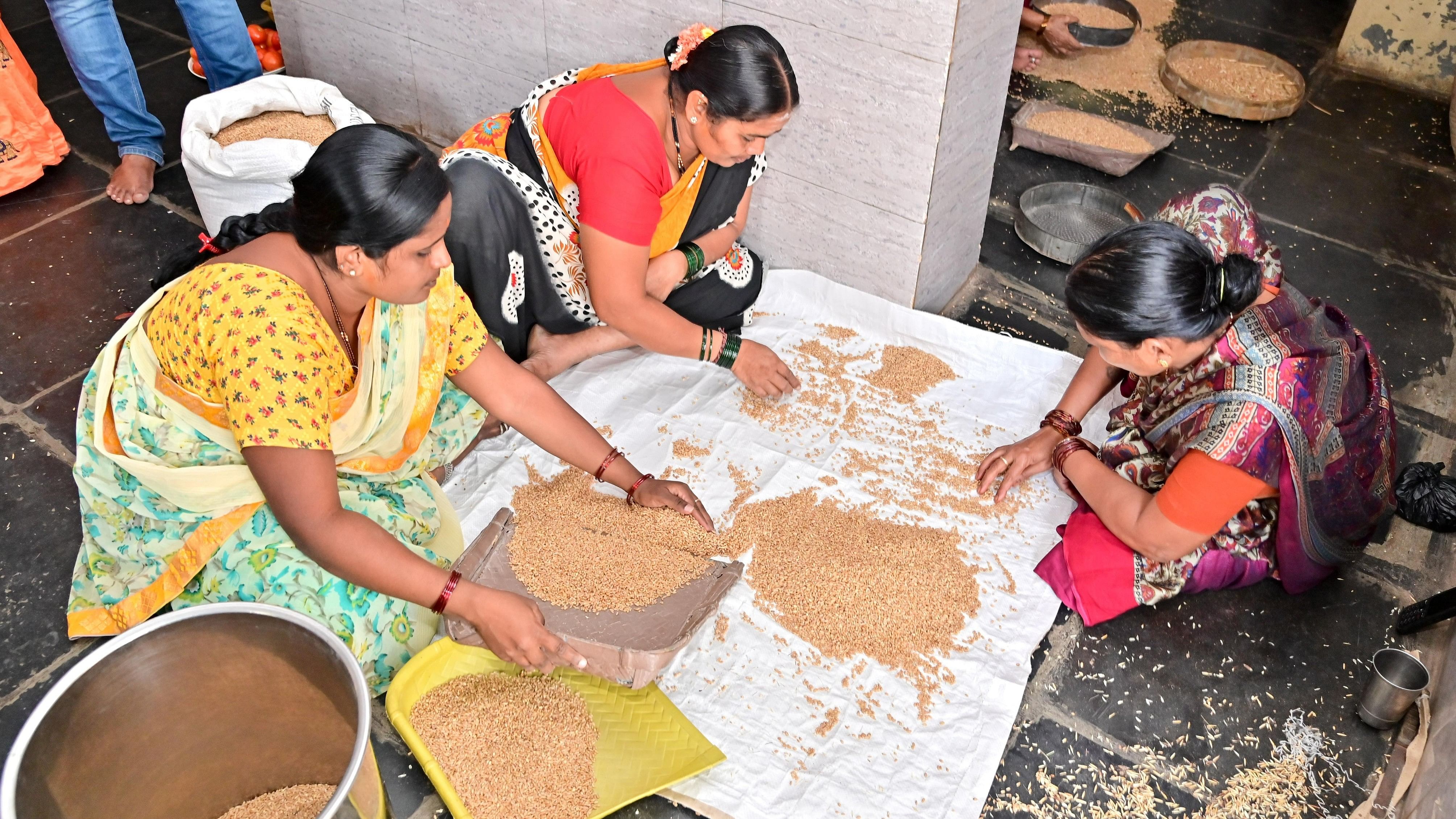
Mid-day meal workers clean the substandard foodgrains at a school in Davangere district. dh file photo
Credit: DH File Photo
Bengaluru: “We have been fighting for nutritional food for schoolchildren for many years. Despite several protests, the quality and quantity of food has gone downhill for the past decade,” says Sumalatha (name changed), the head cook at a school in Kalaburagi.
Sumalatha has been involved in school kitchens for the past 15 years. The price of several essential commodities, particularly vegetables, has grown in the past decade.
Rising costs
However, budgets for key schemes such as the Prime Minister’s Overarching Scheme for Holistic Nutrition (POSHAN) and the Integrated Child Development Services (ICDS) have stagnated and do not account for price rises for essential commodities.
The allocation for the POSHAN scheme in 2014-15, just before the first round of cuts, was at Rs 13,215 crore. The 2023-2024 budget for the scheme is Rs 11,600 crore.
The Right to Food campaign estimates that with rising food costs, the POSHAN scheme would require funding of Rs 20,500 crore. In real-time, this would mean a 43 per cent cut.
The interim budget of 2024 gave some relief — with a 3% increase in allocations to the POSHAN and Saksham schemes, still insufficient to meet the rise in food prices.
On the ground, this manifests in lowered quality and increased labour.
“To meet the foodgrain quantity requirements of the current population of beneficiaries with such budgets, the quality has reduced a lot. We have to sit for hours and clean any foodgrain the government supplies,” she adds.
The PM POSHAN norms prescribe how much protein and carbohydrates a child must be provided. In reality, due to increasing food prices, these requirements are not always met, explains Dipa Sinha, who teaches Economics at Dr B R Ambedkar University, Delhi. “The cooking costs per child need to be revised. This has not happened in the past few years,” she adds.
Material costs are to be revised every year, however, the latest revision came in 2022, after a two-and-a-half-year gap.
With a 9.6 per cent increase in allocation for material costs under PM POSHAN, the price of a midday meal in primary school has been set at Rs 5.45 and in upper primary school at Rs 8.17. Even this rise is insufficient, “an egg alone costs Rs 6,” Sinha adds. Cooking costs for ICDS programme have been ignored for at least five years.
Food inflation
India’s food inflation averaged 6.03 per cent from 2012 to 2024, according to Trading Economics. Vegetable inflation has also increased, averaging 5.7 per cent from 2020 to 2023, compared to 0 per cent from 2016 to 2019. This increase in vegetable prices has contributed to overall rise in average food inflation.
A midday meal cook from Chikkaballapur district explains that the money that School Development and Monitoring Committees (SDMCs) receive for the purchase of vegetables has remained the same.
“Vegetable prices have increased over the past few years. The money is allocated without taking this into account. So, in place of buying 2 kg of vegetables in the market, we are buying 1 kg,” she adds.
Cheaper veggies
Cooks are opting for cheaper vegetables like potato and pumpkin to cut costs.
“Or we use a lesser amount. Instead of 2 kg, we have to buy 1 kg. Sambar is made with fewer vegetables. Many SDMCs and cooks think something is better than nothing, but I do not think that we should approach nutrition like this,” says a cook from Mysuru district.
In anganwadis
A different set of issues plagues anganwadis, explain workers.
“Currently, we have a different menu. We are being provided ready-to-eat meals, but the children are rejecting it,” says an anganwadi worker from Kalaburagi.
Formulated by the Defence Food Research Laboratory in Mysuru, the ready-to-eat khichdi, with a masala packet, has been approved for consumption in anganwadis.
“We are expected to encourage parents to pitch in with vegetables for the khichdi. How long will they sustain the supply though?” she asks.
Even funds for hot meals prepared under maternal nutrition programmes do not account for cooking costs.
The new menu includes a ready-to-eat mixture of dal and other masalas, without including cooking materials such as vegetables and salt.
To meet the needs of the schemes and retain the beneficiaries’ trust, workers sometimes dip into their own funds to fill these gaps.
Irregular funding
“There is no regularity in fund release for cooking costs. Additionally, this affects the payment for cooking gas and rent. We have to scrounge for money then,” says an anganwadi worker from Mysuru district.
The change of menu, without local consultation, is also a matter of much concern in the community.
“We have to feed the children nutritious, local menus in a manner that children will recognise and appreciate. Instead, we are regressing,” she adds.
Without adequate funding, children are being denied a nutritionally sufficient meal derived from diverse sources, explains Raj Shekhar Singh, a member of the Right to Food campaign.
Insufficient calories
“For several years now, menus have focused on meeting the necessary amount of calories. Lack of funding for even these menus means that whatever proteins, vitamins and other nutrients children were deriving from seasonal commodities like vegetables has become lesser in quantity,” he adds.
State government officials declined to comment due to the ongoing elections.